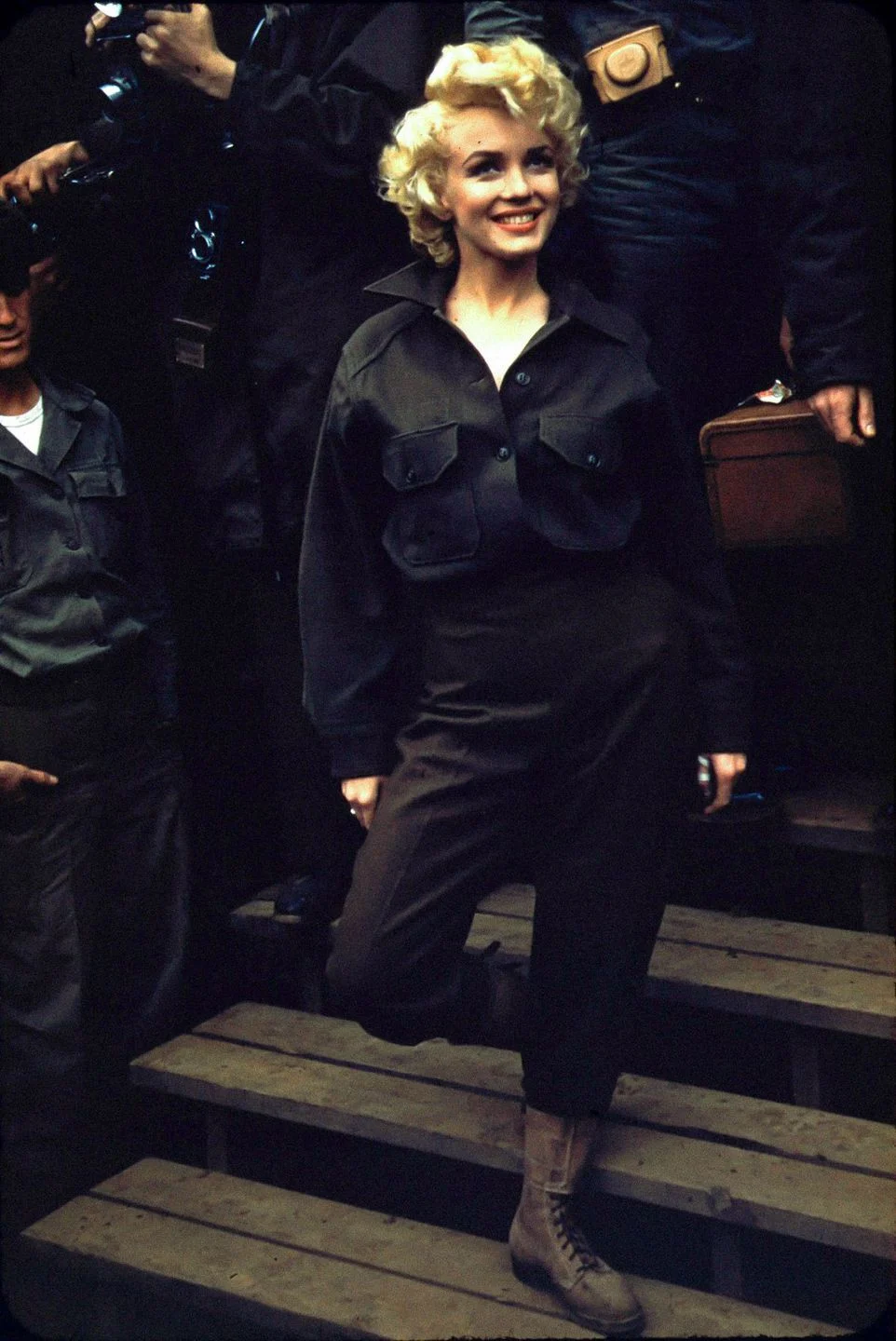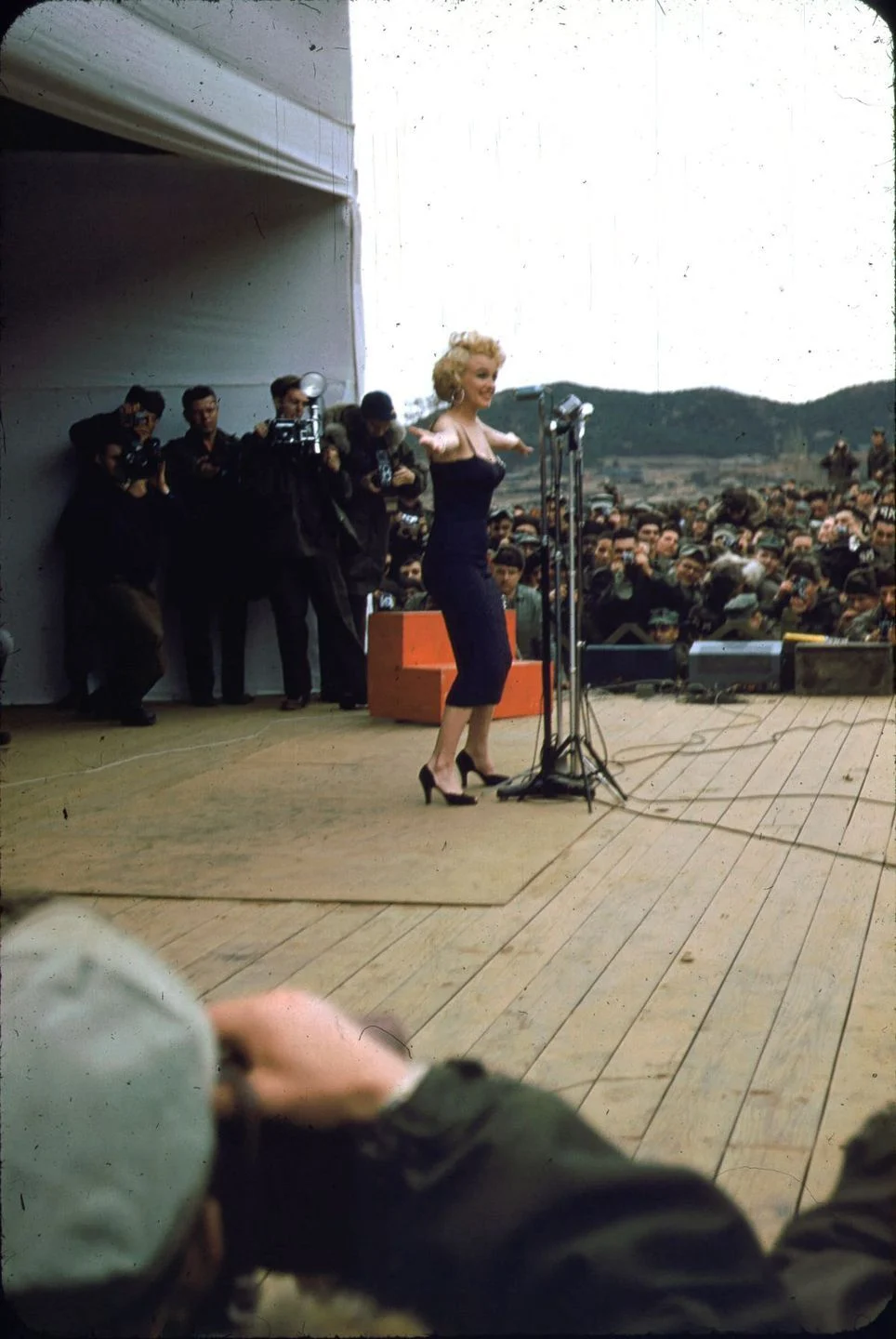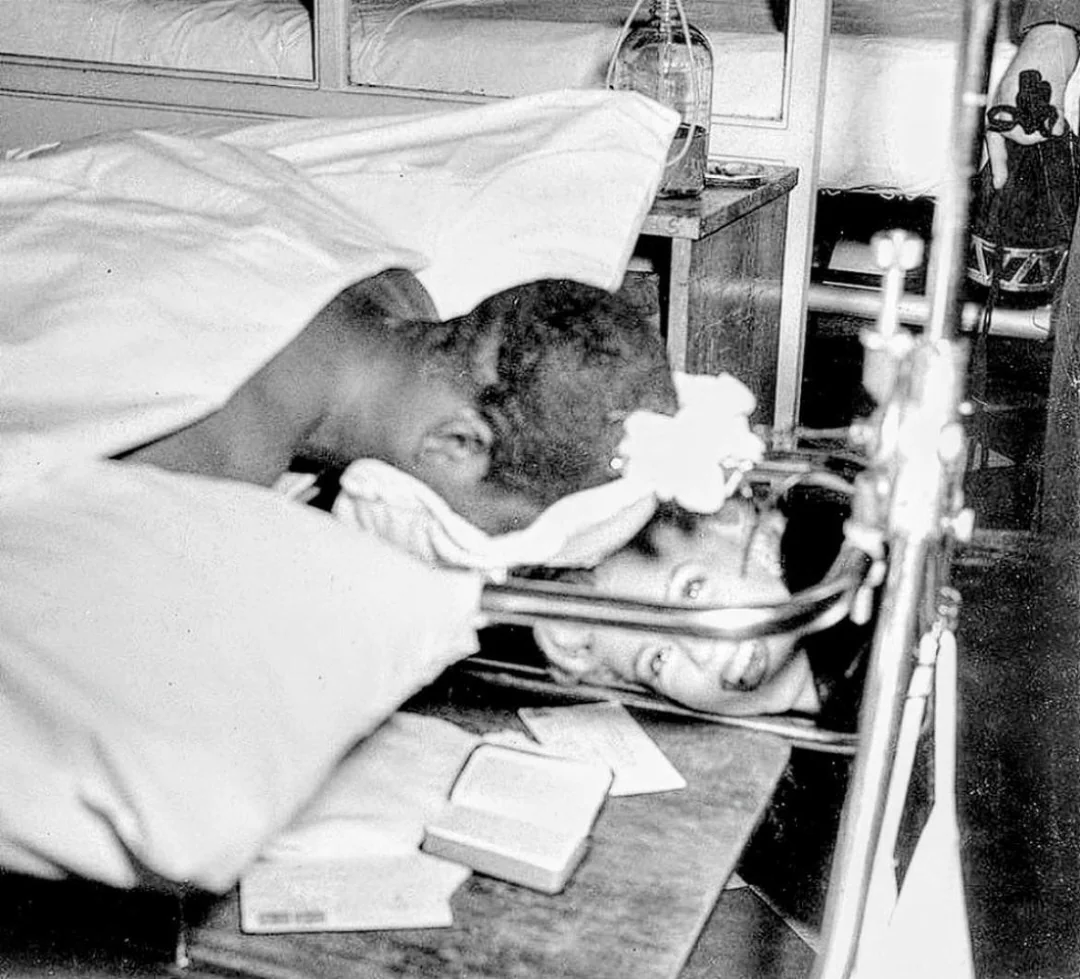When Marilyn Went to War: The Story of Marilyn Monroe’s Visit to the Troops in Korea
- Daniel Holland
- 15 hours ago
- 7 min read

“I never felt like a star before in my life,” Marilyn Monroe said in 1954 after performing for thousands of American soldiers in Korea. “It was the best thing that ever happened to me.”
It was February 1954, and the Korean peninsula was still scarred from three years of brutal conflict. Though the armistice had been signed just months earlier, the country remained a war zone in all but name—its mountains frozen, its fields pockmarked with shell craters, and its soldiers weary beyond their years. Into this bleak landscape came one of Hollywood’s brightest lights: Marilyn Monroe, wrapped in a parka over a sequinned dress, stepping off a military transport plane into sub-zero temperatures.
She was 27 years old, newly married to baseball hero Joe DiMaggio, and on what was supposed to be a quiet honeymoon in Japan. But when she heard that American troops stationed in Korea wanted to see her, she changed her plans immediately. “I’ll go,” she reportedly told her hosts. “They’re my guys.”
It wasn’t an official USO tour. In fact, the decision was spontaneous. Monroe’s presence in Japan had caused a frenzy of press coverage, overshadowing DiMaggio’s baseball clinics there. The U.S. Army saw an opportunity: if she could cross the Sea of Japan and perform for the troops, morale would soar. And so, on February 16, 1954, she boarded a C-54 Skymaster bound for Korea.
“I was scared stiff,” she later admitted. “I’d never been out of the country before except to Mexico, and I didn’t know what to expect.”
“Anything for the Boys”
When Marilyn landed at Seoul’s K-14 airbase, she was met with an icy blast of wind—and the sight of hundreds of soldiers cheering, shouting, and waving from behind makeshift barricades. Many had been stationed there since the height of the fighting. Others had arrived just after the armistice. All were hungry for a taste of home.
“Everywhere you looked there were GIs,” she recalled. “It was like I was back in Hollywood—but with everyone wearing helmets and parkas instead of tuxedos.”
Monroe travelled for four days, performing ten shows at bases from Seoul to the 38th Parallel. Each day she sang and danced in freezing temperatures, sometimes as low as -10°C. “I stood there shivering in my purple gown,” she said later, “but I didn’t care. The warmth came from the men.”
The show, called Anything for the Boys, was simple but electric. She sang “Diamonds Are a Girl’s Best Friend,” “Bye Bye Baby,” and “Do It Again,” with the kind of teasing charm that made her a legend. The soldiers roared their approval, some whistling and shouting her name, others simply standing in stunned silence.
One soldier from the 45th Infantry Division later told Stars and Stripes: “You could have set off a bomb and no one would’ve noticed. Every man there had his eyes on her. For thirty minutes, we forgot where we were.”
A Star Among Soldiers
Monroe was transported between camps in open jeeps and helicopters, braving the bitter Korean winter in a fur-lined parka. Photographs show her beaming at soldiers, shaking hands, and laughing with officers who looked like they couldn’t quite believe their luck. She didn’t just perform; she talked, joked, and posed for countless photos.
At one show, a soldier handed her a handmade sign that read, “Marry me, Marilyn!” She laughed, leaned into the microphone, and quipped, “I already did—but don’t tell Joe.”
Another memory comes from a corporal who wrote home that evening: “It was the first time we’d smiled in months. She was glowing, not because of the spotlights, but because she actually cared. You could tell she was happy to see us.”
In an interview years later, Monroe herself remembered how overwhelming it felt. “It was the first time I felt that people actually liked me for being me,” she said. “Not for the way I looked, not for the movie publicity—just me.”
The soldiers, many of whom had endured the horrors of trench warfare and freezing nights in foxholes, were equally moved. “It wasn’t just entertainment,” wrote one private in a letter published in Life magazine. “It was like having a little piece of home dropped into the middle of nowhere.”
Joe DiMaggio and the Honeymoon That Wasn’t
Back in Japan, DiMaggio was reportedly less enthusiastic about his wife’s sudden detour. The pair had married just weeks earlier, on January 14, 1954, in San Francisco. Their honeymoon was meant to be private—a quiet escape for one of America’s most famous couples. But Monroe’s star power quickly overshadowed the baseball legend.
When she returned to Tokyo after the Korea trip, the press asked about her experience. “It was wonderful,” she gushed. “Joe, you never heard such cheering!”
DiMaggio, who was known for his reserved nature, replied curtly, “Yes, I have.”
That exchange would later become one of the most famous lines in the folklore of their troubled marriage. Some biographers suggest that the Korea trip marked the first real crack in their relationship. Monroe’s fame had outshone even the great DiMaggio, and he didn’t quite know how to handle it.
But to the men she entertained, none of that mattered. They had seen a Hollywood goddess in the flesh, singing her heart out in a frozen field, and for those few days, she belonged to them.
A “Spiritual Experience”
Marilyn spoke about the Korea trip many times afterward, often with visible emotion. “It was the best thing that ever happened to me,” she said in an interview for Modern Screen later that year. “I never felt like a star before in my life—it was so wonderful to feel appreciated, to feel that I was part of something.”
She called it a “spiritual experience.” For someone who had spent much of her career battling self-doubt, studio control, and public misunderstanding, the sincerity of the soldiers’ response seemed to reach her deeply. “I always wanted to be loved by people, to feel I belonged somewhere,” she once told a friend. “And there, for the first time, I felt like I did.”
According to a report by Army publicist Alan Levy, Monroe’s performances drew more than 100,000 soldiers in total—a staggering number considering the logistical challenges. Some troops reportedly travelled miles through snow and ice just to catch a glimpse of her.
“She didn’t act like she was doing us a favour,” one veteran recalled decades later. “She looked like she wanted to be there as much as we wanted her to be. That’s what made it so special.”
The Gown, the Cold, and the Legend
Of all the images from that week, one remains iconic: Monroe standing on an outdoor stage at the 1st Marine Division camp near Daegu, dressed in a figure-hugging, strapless purple sequin gown, her platinum hair gleaming under military spotlights. Around her, an ocean of men in heavy coats and helmets, their breath visible in the frigid air.
It was an improbable sight—Hollywood glamour meeting the grit of post-war Korea. “I was freezing,” she later said with a laugh. “But I think they were warmer for it.”
After each show, she took time to meet the men personally, shaking hands and signing autographs until her fingers were numb. “She didn’t rush off to a warm tent like some stars might have,” recalled a sergeant from the 187th Airborne. “She stayed, even when the generals told her it was too cold.”
That purple dress would later become one of her most famous costumes, now displayed in museums and exhibitions as a symbol of her enduring connection to the troops who adored her.
Letters Home and Lasting Memories
In the weeks following her visit, letters and reports flooded American newspapers and magazines. A Marine corporal wrote home to his mother in Ohio:
“She sang like an angel, smiled like she meant it, and when she waved, you felt like she was waving just at you.”
Another wrote: “There’s a lot of talk about morale boosters, but nothing beats having Marilyn Monroe show up in the middle of Korea.”
Photographer Harold “Doc” Edgerton, who captured many of the now-famous images of her trip, recalled that Monroe insisted on meeting as many soldiers as possible. “She didn’t just stand there and perform,” he said. “She asked about their families, where they were from, and whether they’d be going home soon.”
Many of those men never forgot it. In interviews decades later, Korean War veterans often spoke of Marilyn’s visit as a highlight of their service. One veteran said,
“We saw presidents, generals, and celebrities, but no one came close to her. She had this glow about her that you couldn’t explain.”
A Star Who Came Back Changed
When Monroe returned to Japan, she was physically exhausted but emotionally elated. She described feeling “reborn” by the experience. “It made me realise that people could really care about you without wanting anything in return,” she told a friend.
Joe DiMaggio, however, was reportedly unimpressed. Their relationship, already under strain, would deteriorate over the following months, leading to their divorce later that year. But Monroe’s time in Korea remained untarnished in her memory. She often spoke of it as one of the most meaningful experiences of her life.
Her friend and acting coach Natasha Lytess later said, “Marilyn was never prouder of herself than she was after Korea. It was the first time she saw the effect she could have on people—not just as a sex symbol, but as a human being.”
Legacy of a Visit
Today, Marilyn Monroe’s trip to Korea is often overshadowed by the glittering highs and tragic lows of her short life. But for those few winter days in 1954, she was more than a movie star. She was a lifeline of laughter and light for men who had seen too little of either.
Her performances were never recorded, and only still photographs remain, but those who were there still remember the sound of her voice cutting through the cold air, the laughter she inspired, and the feeling that, just for a moment, everything was all right.
In 2008, a veteran named Bill Hutton reflected in an interview: “You can’t imagine what it was like. It was twenty below zero, and we were standing there grinning like fools. That woman didn’t just sing—she thawed our hearts.”
For Marilyn Monroe, who spent much of her life seeking love and belonging, that trip may have been the one time she truly found both.
Sources
Stars and Stripes, “Marilyn Brings a Smile to Korea,” February 1954.
Life Magazine Archives, 1954 issue featuring Monroe in Korea.
Donald Spoto, Marilyn Monroe: The Biography (HarperCollins, 1993).
Lois Banner, Marilyn: The Passion and the Paradox (Bloomsbury, 2012).
Anthony Summers, Goddess: The Secret Lives of Marilyn Monroe (Macmillan, 1985).
U.S. Army Photo Archives, National Museum of American History.
BBC History, “Marilyn Monroe’s Korean Adventure,” (https://www.bbc.com/news/magazine-25661760).
LIFE Photo Collection, “Marilyn Monroe Entertains the Troops in Korea, 1954” (https://life.com/).

































































